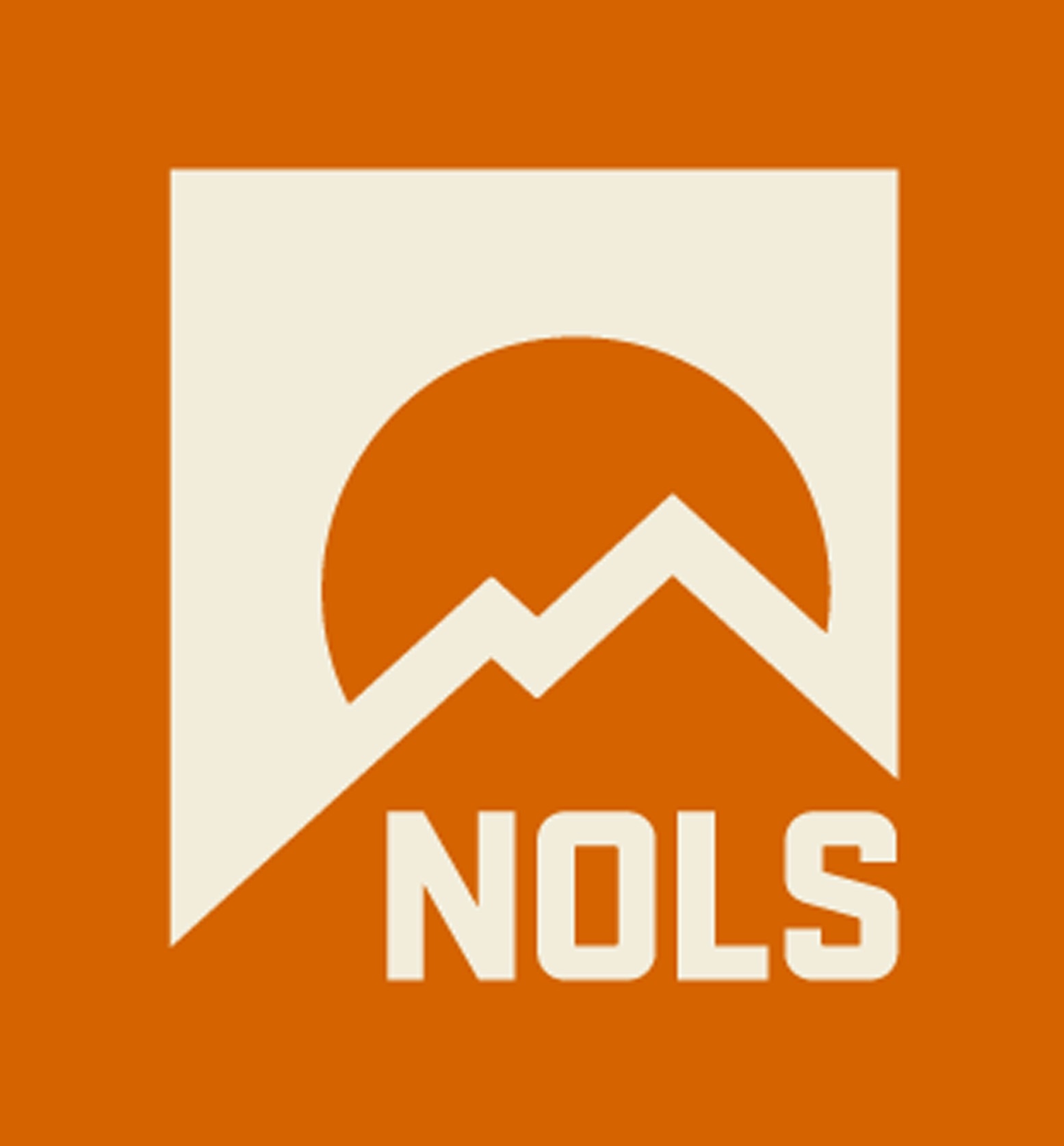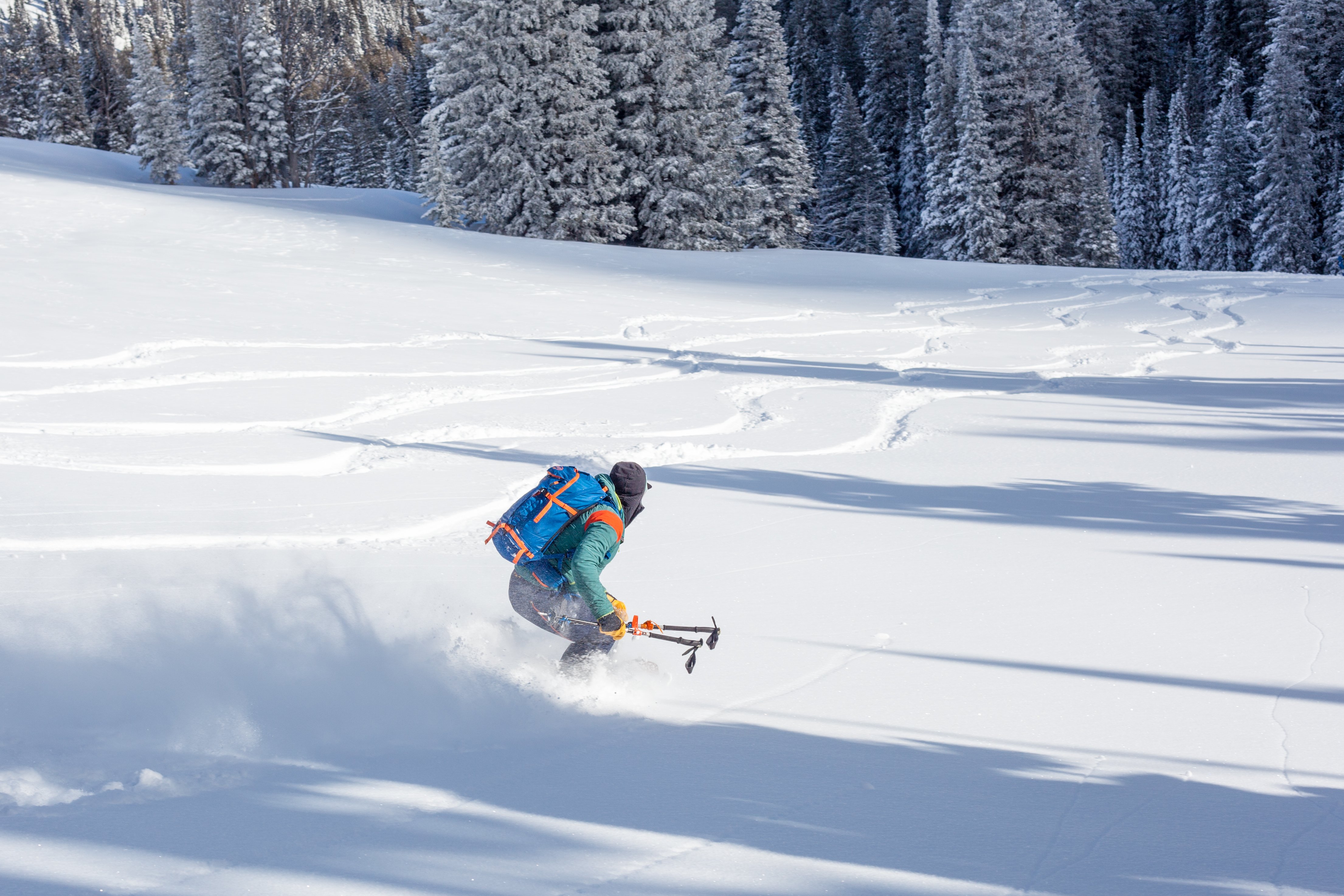Whether clipping into a board for the first time or getting ready to embark on your first backcountry expedition with NOLS, having a solid foundation of snowboard basics can benefit even the most experienced snowboarders.
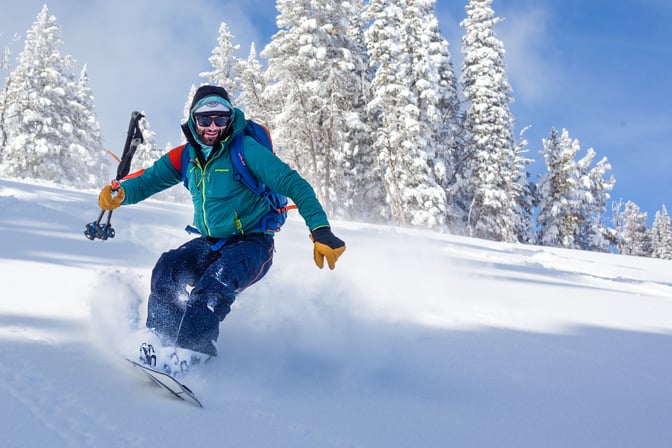 Photo by Molly Hagbrand
Photo by Molly Hagbrand
At NOLS, our dedicated instructors, fueled by a shared passion for snowboarding and backcountry travel, impart not just the fundamental techniques of the sport, but also instill a commitment to personal and communal growth, leadership development, and proficient risk management. Our aim extends beyond teaching you to snowboard. We strive to provide an all-encompassing experience that transcends the snowy terrain.
While our snowboarding courses are tailored to accommodate a spectrum of skill levels, we highly recommend taking preliminary lessons to build a solid foundation before considering enrollment in our challenging backcountry snowboarding courses.
Start by familiarizing yourself with the fundamentals of snowboarding gear, terminology, and technique!
What Beginner Snowboarders Should Know
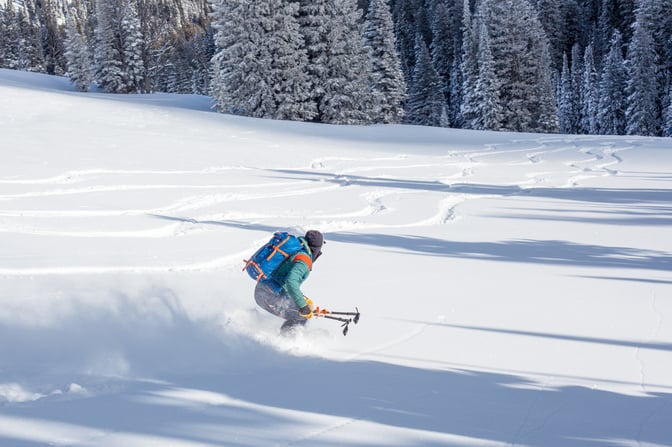 Photo by Molly Hagbrand
Photo by Molly Hagbrand
An Introduction to Ski Terminology
Types of Skiing
- Splitboarding: Splitboarding seamlessly merges the worlds of snowboarding and backcountry travel, allowing riders to ascend slopes by skiing and then descend through snowboarding. The necessary equipment for splitboarding includes a splitboard, which can be divided into skis, and climbing skins, which can be attached to the skis for traversing flat and uphill terrain. This style proves ideal for those seeking to access remote, untouched terrain. Learn more about the Backcountry Splitboarding.
- Backcountry Snowboarding: While we’re calling it “backcountry snowboarding” here, it's important to note that backcountry snowboarding involves the use of a splitboard instead of a normal snowboard. Backcountry travel involves navigating untouched, wild terrain beyond established ski resorts. Riders venture into unpatrolled, remote areas, and because of this, backcountry snowboarding (or splitboarding) is dangerous without proper avalanche training. NOLS snowboarding courses take place mostly in the backcountry and equip riders with the necessary avalanche training and splitboarding skills.
- Freestyle Snowboarding: Freestyle snowboarding focuses on tricks, jumps, and maneuvers executed in terrain parks, halfpipes, and amidst natural features. The riding experience encompasses a variety of elements, including jumps, rails, boxes, halfpipes, and diverse obstacles. Popular tricks within this style include spins, grabs, flips, and jibs, which involve skillfully riding on non-snow surfaces.
- Freeride Snowboarding: Not to be confused with freestyle, freeride snowboarding involves navigating natural and ungroomed terrain, actively seeking out powder, tree-lined routes, and challenging conditions. Features of freeride include off-piste areas, powder-filled slopes, and backcountry terrain, with a primary emphasis on the sheer joy of riding in natural, untracked snow.
- Big Mountain or Extreme Snowboarding: This type takes riders into challenging and often extreme alpine terrain, such as steep chutes and cliffs. Features of this style include rugged, ungroomed, and demanding mountainous terrain, with a focus on technical skill, navigation, and effective risk management.
- Carving or Alpine Snowboarding: This snowboarding type is centered around making smooth, deep turns at high speeds on well-groomed slopes. This style thrives on meticulously groomed trails and employs carving-specific equipment. The technique in alpine snowboarding requires precise edge control and strategic body positioning for optimal carving performance.
Snowboarding Stances and Techniques
- Carving: Creating smooth turns on snow, blending precise edge control and weight distribution for elegant, fluid movements on groomed slopes.
- Jibbing: The playful side of snowboarding, involving tricks on non-snow surfaces like rails and boxes. Riders showcase creativity and style, adding an urban-inspired flair to the sport.
- Powder Riding: Navigating deep snow with techniques like weight distribution and wider turns. It demands a surf-like approach, embracing the unique challenges and pleasures of powder conditions.
- Switch Riding: Using the opposite foot forward, switch riding adds versatility and creativity. Whether for tricks or style, it challenges riders to adapt, enhancing their overall proficiency and expanding the range of possibilities.Carving involves making precise turns on the snow by leaning into the edges of the skis. This advanced technique enhances control and maneuverability on the slopes.
- Regular Stance: This snowboard stance involves riding with the left foot forward, forming the foundation for most riders.
- Goofy Stance: This snowboard stance entails riding with the right foot forward, providing a unique approach.
- Fakie Riding: Fakie riding in snowboarding involves moving backward down the slope without changing the regular stance. It's used for tricks and style variations, challenging riders to navigate in reverse without altering their front foot and back foot placement, adding creativity and skill to their repertoire.
Snow Conditions, Trails, and Areas
- Groomed Slopes: A groomed slope offers smooth, meticulously prepared trails on the mountain, providing an ideal surface for carving and cruising.
- Moguls: Moguls add a dynamic challenge, forming bumps in the snow created by snowboarders and snowboarders. These irregularities demand navigation skill and agility, providing a different experience than groomed trails.
- Powder: Fresh, untouched, unpacked snow, offering a thrilling and buoyant ride down the mountain.
- Piste: A piste is a marked and maintained ski trail, often graded by difficulty. Snowboarders can choose pistes that match their skill level for a tailored experience.
- Terrain Park: Terrain parks are specially designed areas with jumps, rails, and various features tailored for freestyle snowboarding. Riders showcase tricks, spins, and stylish maneuvers, turning these zones into playgrounds for creativity and expression.
- Halfpipes: Common in terrain parks, halfpipes present a distinctive feature—a U-shaped, snow-cut channel—where freestyle snowboarders perform aerial maneuvers. Spins, flips, and grabs unfold within the halfpipe, combining technical skill and artistic flair, creating a visually captivating aspect of the snowboarding experience.
Snowboard and Ski Lift Terms
Snowboard and ski lifts are common at most resorts, providing snowboarders with convenient transportation up the mountain before cruising downhill. Here are common types of lifts and their definitions:
- Chairlift: A chairlift is a lift where snowboarders are seated on chairs suspended from an overhead cable, facilitating efficient transportation to elevated slopes.
- Gondola: A gondola is an enclosed lift that carries snowboarders up the mountain in cabins, offering protection from the elements during the ascent.
- T-Bar: A T-Bar is a surface lift where snowboarders are pulled uphill by a T-shaped bar, providing an alternative means of ascending slopes.
Snowboarding Gear Basics & Essentials
Getting the right gear is crucial for an enjoyable snowboarding experience. Whether you're a beginner or looking to upgrade your equipment, here's a list of essential snowboarding gear terms to help you navigate the world of equipment:
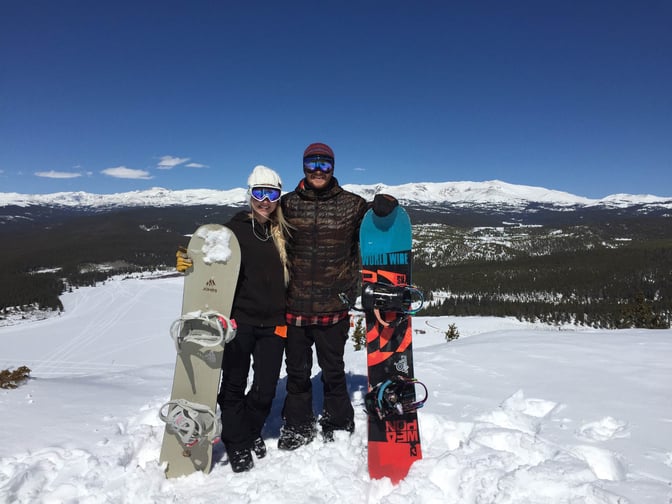 Photo by Sarah Buer
Photo by Sarah Buer
- Snowboards: The snowboard is the quintessential tool for conquering snow-covered slopes, serving as your vehicle for carving turns, executing tricks, and gliding through the powder. Available in various shapes and sizes, selecting the right snowboard tailored to your riding style and skill level is paramount for an enjoyable and successful experience on the mountain.
- Freestyle Boards: Shorter and more maneuverable for tricks and park riding.
- Freeride Boards: Designed for all-mountain riding and powder conditions.
- Alpine or Carving Boards: Longer, narrower, and designed for carving on groomed slopes.
- Bindings: The devices that secure your boots to the snowboard, playing a pivotal role in translating your movements to the board. They provide the necessary control and responsiveness, allowing riders to navigate downhill and carve through turns.
- Snowboard Boots: Snowboard boots are crafted to offer a harmonious blend of ankle support, comfort, and responsiveness. Designed with specialized features such as lacing systems and insulation, they provide the foundation for a rider's connection to the snowboard. The right pair of snowboard boots increases stability, control, and a comfortable fit, enhancing your overall riding experience.
- Stomp Pad: Positioned strategically between the bindings, the stomp pad is a textured area on the snowboard that provides traction for one foot when not strapped in.
- Snowboard Goggles: Protective eyewear that provides clear vision in various light conditions and shields against wind, snow, and harmful UV rays. Snowboard goggles contribute to optimal visibility as you navigate the slopes. Choosing goggles with anti-fog features and suitable lens tints enhances the overall enjoyment of your ride.
- Snowboard Helmet: Essential form of head protection. Designed to absorb impact and protect the head from potential injuries, helmets are a non-negotiable element of your snowboarding kit. Whether you're a beginner snowboarder or an experienced rider, wearing a helmet is a smart and responsible choice.
- Wrist Guards: Especially important for beginners, wrist guards are protective gear designed to prevent injuries during falls. As novices often instinctively use their hands to break a fall, wrist guards offer crucial support and protection, reducing the risk of wrist injuries and allowing riders to progress with confidence.
- Multi-Layer Cold Weather Gear: Stay warm and dry on the slopes with a well-equipped cold-weather ensemble. Insulated gloves protect hands, while multi-layer gear, including moisture-wicking base and thermal mid-layers, and waterproof outerwear, shields against the elements. Complete the setup with insulated socks and a balaclava or face mask for a comfortable and protected snowboarding experience.
- Waxing Kit: Consisting of tools and wax, this kit helps keep the base of your board smooth, reducing friction and enhancing glide. Regular waxing not only improves speed and maneuverability but also prolongs the life of your board.
- Avalanche Safety Gear: Avalanche safety gear is non-negotiable for those venturing into the backcountry. This essential kit includes a beacon for locating buried individuals, a probe for pinpointing their exact location, and a shovel for efficient snow removal during rescue efforts. Familiarizing yourself with proper usage and practicing avalanche safety protocols is crucial when exploring off-piste terrain.
Choosing the Right Equipment for Your First Snowboarding Trip
When preparing for your first snowboarding experience, understanding the basics of snowboarding gear will set you on the path to making informed decisions and enhancing your well-being and enjoyment.
The great thing for beginner snowboarders is that most resorts cater specifically to beginners by offering rental options for essential gear, including snowboards, boots, helmets, and goggles. Renting allows you to experiment with different equipment and with the sport without committing to a purchase upfront. Take advantage of this opportunity to familiarize yourself with the feel of the gear and gain confidence on the slopes.
If you decide to invest in your own snowboard, consider the type that suits beginners, typically an all-mountain or freestyle board. Comfortable and well-fitted snowboard boots are paramount for a positive experience. A snug fit enhances control and confidence, which is especially crucial for beginners. Choose goggles that provide effective shielding against wind, snow, and UV rays. Look for options with anti-fog features and suitable lens tints for different weather conditions.
Additionally, investing in a helmet that offers a secure fit, efficient ventilation, and lightweight construction is a non-negotiable piece of equipment for riders of all levels.
When in doubt, seek guidance from professionals at your local ski shop. They can offer personalized advice based on your individual needs and help you find the right fit for your equipment. They can also help you make sure the board's size and flex align with your weight, height, and skill level.
By choosing the right equipment tailored to your needs and skill level, you set the foundation for a memorable and enjoyable introduction to the world of snowboarding.
Foundational Snowboarding Skills & Techniques
Gaining sufficient practice in the art of steering and turning while on skis is a fundamental skill that lays the foundation for an enjoyable experience on the slopes.
This foundation encompasses a comprehensive understanding of the mechanics of steering, turning, braking, speed control, uphill snowboarding, and other basic maneuvers. These skills form the bedrock for navigating alpine and backcountry landscapes with more control.
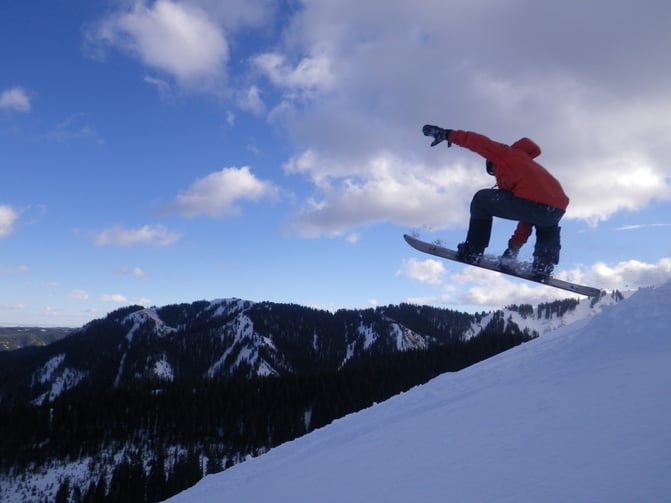 Photo by Amy Whitaker
Photo by Amy Whitaker
Snowboard Stance and Balance
Establishing the right stance is fundamental in snowboarding. Your snowboard instructor will likely emphasize finding a comfortable and natural stance, whether it's "regular" (left foot forward) or "goofy" (right foot forward).
Through hands-on instruction and practice, you'll learn the nuances of weight distribution and how to maintain balance, setting the stage for fluid movements on the board. Here are some stance and stability tips you'll cover in most snowboard lessons even before hitting your first bunny hill:
1. Bent Knees:
Maintain a relaxed and athletic stance by bending your knees. This provides flexibility and absorption of bumps, allowing for better control. Keep your back straight and your weight centered over your board.
2. Align Your Shoulders and Hips:
Check that your shoulders and hips are parallel to the board. This alignment helps maintain stability and facilitates smoother turns. Avoid leaning too far forward or backward, as it can disrupt your balance.
3. Center of Gravity:
Your center of gravity is crucial for stability. Keep it positioned over the midpoint of your snowboard. Engage your core muscles to maintain balance, preventing falls and contributing to a controlled descent down the slopes.
Steering and Turning Techniques:
Steering and turning a snowboard involves a rhythmical combination of weight shifts, edge control, and body movements.
1. Toeside Edge and Heelside Edge:
Understanding how to utilize your toe and heel edges is fundamental to steering and turning. Your snowboard has two edges – the toeside edge (the side facing your toes) and the heelside edge (the side facing your heels). To initiate turns, shift your weight to the respective edge. Leaning forward onto your toe edge initiates a toe-side turn while leaning back onto your heel edge initiates a heelside turn.
2. Body Rotation:
As you initiate a turn, allow your upper body to rotate in the direction of the turn naturally. Your shoulders should align with the direction you want to go, helping your board follow suit. Keep your movements fluid and controlled, avoiding rigid, jerky motions.
Controlling Speed on a Snowboard:
Controlling the speed of a snowboard involves mastering various techniques that require a combination of body movements. To effectively manage your speed, maintain a forward lean with slightly bent knees and keep your weight centered over the snowboard. Achieving the right balance is crucial to prevent loss of control and excessive speed.
1. S-Turns:
To manage speed effectively, practice S-turns. Initiate a toe-side turn, then smoothly transition into a heel-side turn, creating an 'S' shape down the slope. Gradually widen or narrow your turns to adjust your speed.
2. Edge Control:
Mastering edge control is key to managing speed. Gently press on your edges to increase friction with the snow, slowing down your descent. Practice shifting your weight from edge to edge to find the right balance for controlled acceleration.
3. Use Your Body as a Brake:
In situations where you need to slow down quickly, shift your weight to your back foot and gently press your heel edge into the snow. This acts as a brake, slowing your momentum.
Backcountry Snowboard Travel with NOLS
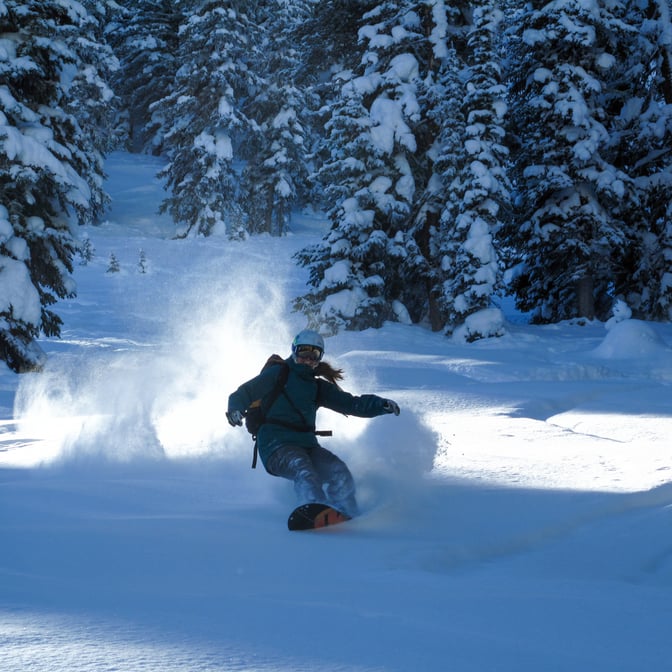 Photo by Aj Linnell
Photo by Aj Linnell
At NOLS, our snowboarding courses take place primarily in the backcountry, which is vastly different from the terrain parks and bunny slopes you might be familiar with.
Backcountry snowboarding refers to snowboarding in natural, uncontrolled, and undeveloped snow-covered terrain, typically away from ski resorts and designated groomed slopes. It involves exploring and riding in remote, mountainous areas where the snow is untouched and conditions can be more challenging.
Here are key aspects of backcountry snowboarding and how it differs from regular snowboarding:
Terrain: Backcountry Snowboarding vs. Regular Snowboarding
- Backcountry: Involves riding in natural, ungroomed terrain such as open bowls, steep chutes, glades, and mountainous areas. Riders may encounter a variety of snow conditions, including powder, packed powder, and variable snow.
- Regular: Takes place on groomed slopes within established ski resorts, where the terrain is manicured, and snow conditions are regularly maintained.
Access: Backcountry Snowboarding vs. Regular Snowboarding
- Backcountry: Accessible by hiking, snowshoeing, or using specialized backcountry equipment like splitboards and climbing skins.
- Regular: Accessible by chairlifts, gondolas, or surface lifts within the infrastructure of a ski resort.
Risk Level: Backcountry Snowboarding vs. Regular Snowboarding
- Backcountry: Involves inherent risks associated with navigating through uncontrolled terrain, including avalanches, exposure to extreme weather, and the need for knowledge of snow conditions and proper equipment such as avalanche beacons, shovels, and probes.
- Regular: Ski resorts implement risk management measures, such as avalanche control, patrolled slopes, and marked boundaries, reducing certain risks associated with backcountry riding.
Experience and Skill Level: Backcountry Snowboarding vs. Regular Snowboarding
- Backcountry: Requires a higher level of skill, experience, and knowledge of snow science, navigation, and avalanche safety. Riders often need to be proficient in backcountry travel and survival skills. We encourage beginner snowboarders to take a few snowboard lessons and become comfortable on the snow before enrolling in our backcountry snowboarding courses.
- Regular: Suitable for a wide range of skill levels, from beginners to advanced riders, with groomed slopes catering to various abilities.
Equipment: Backcountry Snowboarding vs. Regular Snowboarding
- Backcountry: Specialized equipment such as splitboards (a snowboard that splits into two skis for ascending, we use splitboards throughout our snowboarding courses), climbing skins, and avalanche safety gear are often used. Backpacks may be equipped with essentials like water, food, extra layers, and first aid supplies.
- Regular: Standard snowboarding equipment, including snowboards, bindings, boots, and helmets, is used in ski resorts.
Environment: Backcountry Snowboarding vs. Regular Snowboarding
- Backcountry: Offers a more immersive and natural experience, with the potential for solitude and breathtaking scenery. Our backcountry snowboarding courses offer you the chance to navigate once-in-a-lifetime remote locations that are otherwise largely unaccessible.
- Regular: Involves sharing slopes with other skiers and snowboarders in a more controlled and developed environment.
It's important for those interested in backcountry snowboarding to have proper training, experience, and equipment, and to be aware of the potential hazards associated with exploring unmanaged mountain terrain. Backcountry riders should take an avalanche training course and always carry essential gear to mitigate risks.
At NOLS, we recommend that beginners take a few snowboarding lessons prior to enrolling in our courses. Coming with the fundamental skills and knowledge for snowboarding will allow you to prioritize learning how to navigate the backcountry using a splitboard, assess avalanche risks, and train in avalanche rescue.
Important Snowboarding Tips for Beginners
Embarking on your snowboarding journey is exhilarating, but like any new adventure, it comes with its set of challenges.
Snowboarding Tips for the Slopes
Here are a few tips to help you navigate the slopes and make the most of your snowboarding experience:
- Start with a Lesson: Enroll in a beginner's snowboarding lesson to gain a solid foundation. Professional instructors can provide essential guidance on balancing, turning, and stopping, contributing to a more enjoyable experience.
- Be Mindful of Others: Respect the mountain and fellow riders by being aware of your surroundings. Yield to others when necessary, and be courteous on the slopes. Following mountain etiquette nurtures a positive experience for everyone.
- Gear Up Properly: Renting a snowboard and boots is a great way to try the sport and get a feel for what you like and don’t like in a board and boots. When you are ready to buy your own snowboard and boots, invest time in selecting the right gear. A well-fitted snowboard, boots, and bindings are essential for comfort and control. Don't forget a helmet, wrist guards, and appropriate clothing to keep you warm and protected.
- Hone the Basics: Begin with the basics by practicing your stance and balance on flat terrain. Learn how to strap in and out of your bindings comfortably. These fundamental skills will build confidence before you tackle more challenging slopes.
- Understand Your Stance: Experiment with your stance to find what feels most natural and comfortable. Whether you prefer a regular (left foot forward) or goofy (right foot forward) stance, finding the right balance is crucial for stability and control.
- Learn to Fall with Control: Falling is inevitable, especially for beginners. Practice falling in a controlled manner to minimize the risk of injury. Tuck your chin, relax your muscles, and try to roll rather than absorbing the impact with your hands.
- Practice Your Edges: Understanding how to use your board's edges is essential for steering and controlling your speed. Spend time practicing on gentle slopes, mastering both toe-side and heel-side turns before progressing to more challenging terrain.
- Control Your Speed: Learning to control your speed helps reduce risk of injury on the slopes. Practice using your edges and leaning forward to control your descent. Keep your knees slightly bent and your weight centered to maintain balance.
- Stay Hydrated and Energized: Snowboarding can be physically demanding, so it's essential to stay hydrated and fueled. Pack water and snacks to keep your energy levels up, allowing you to make the most of your time on the mountain.
- Progress at Your Own Pace: Every rider progresses differently. Don't be discouraged if you see others advancing faster. Focus on building your skills gradually, and enjoy the learning process. The key is consistency and a positive mindset.
Backcountry Snowboarding & Splitboarding Preparation
At NOLS, our snowboarding expeditions unfold in the vast backcountry, presenting unique challenges and risks, especially for those lacking proper avalanche training.
Venturing into unmarked and unpredictable backcountry terrain without the necessary skills can lead to life-threatening situations. It is crucial for anyone interested in backcountry snowboarding to prioritize avalanche training and risk management, along with the technical skills associated with snowboarding.
A Note on Splitboarding
While we use the term "backcountry snowboarding" in this article, we do want to point out that, in our snowboarding backcountry courses, we utilize splitboards rather than normal snowboards. A splitboard is a snowboard that can be split into two separate skis for climbing uphill and then rejoined for downhill riding. This innovation in snow sports makes backcountry snowboarding possible by providing the necessary means for traversing diverse terrains.
Dangers of Backcountry Snowboarding Without Avalanche Training
Backcountry snowboarding introduces an elevated level of risk due to the potential for avalanches, and this risk is significantly increased for individuals without proper training.
Avalanche terrain demands a comprehensive understanding of snowpack stability, weather conditions, and route planning. Without this knowledge, snowboarders may unknowingly expose themselves to avalanche-prone areas, leading to severe consequences.
Importance of Avalanche Training and Certification
To mitigate the risks associated with backcountry snowboarding, we strongly advise you to participate in specialized avalanche training. Our winter courses include avalanche training and certifications to equip snowboarders with the essential skills needed to make informed decisions in avalanche-prone terrain.
Interested in learning more? Check out our Teton Valley Backcountry Avalanche Training (TVA) course!
Key Recommendations for Backcountry Snowboarding:
- Never Go Alone: Avoid venturing into the backcountry alone. Always snowboard with a partner or a group to reduce risk through teamwork, communication, and mutual support.
- Get Proper Training: Enroll in an avalanche training course to understand the intricacies of snow science, terrain assessment, and rescue techniques. Certification provides a solid foundation for making sound decisions in avalanche-prone areas.
- Practice Proper Risk Management: Develop a habit of assessing risks and making informed decisions based on current conditions. This includes staying updated on weather forecasts, snowpack conditions, and recent avalanche activity.
- Carry Essential Avalanche Gear: Always carry essential avalanche safety equipment, including a beacon, probe, and shovel. Seek guidance from a professional to make sure you know how to use this equipment effectively.
- Know Your Limits: Be honest about your snowboarding abilities and fitness level. Avoid pushing beyond your limits, especially in unfamiliar and challenging terrain.
- Stay Informed: Regularly update your knowledge of backcountry risk management and avalanche awareness. Conditions can change rapidly, and staying informed is crucial for making real-time decisions.
Remember, backcountry snowboarding is an exhilarating but potentially hazardous activity. Prioritize your well-being and that of those around you by investing in proper avalanche training and consistently practicing responsible backcountry snowboarding habits.
Explore NOLS Snowboarding Courses!
As you gear up for your first snowboarding journey, armed with newfound knowledge and skills, remember that there's no shame in returning to the basics. Whether you find yourself eager to cruise groomed slopes, explore backcountry terrain, or master tricks in a terrain park, the journey is uniquely yours.
We offer immersive snowboarding courses & certifications that include the essentials of avalanche training and backcountry terrain risk management, including courses for those who are newer to snowboarding:
- Fall Semester in the Rockies with WFR
- Spring Semester in the Rockies with WFR
- Fall Semester for Outdoor Educators
- Spring Semester for Outdoor Educators
- Spring Semester in the Rockies
These courses, led by seasoned instructors with a wealth of snowboarding, splitboarding, and backcountry travel experience, delve into the intricacies of splitboarding and snowboarding techniques, emphasizing personal growth, leadership development, and effective risk management.
Curious about skiing, as well? Check out our blog post: Skiing vs. Snowboarding: Which one is for you?
As a note, we recommend that total beginners take a few snowboarding lessons before enrolling in a NOLS course.
Written By
NOLS
NOLS is a nonprofit global wilderness school that seeks to help you step forward boldly as a leader.


